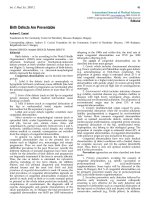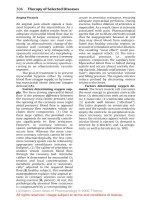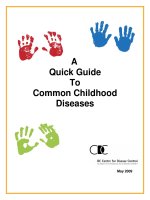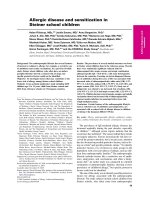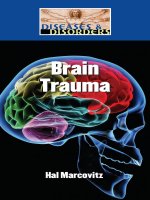Allergic diseases
Bạn đang xem bản rút gọn của tài liệu. Xem và tải ngay bản đầy đủ của tài liệu tại đây (3.07 MB, 98 trang )
Allergic disease
Katalin Molnár MD
Contents
• Atopy, Allergy, Hypersensitivity reactions
• Pathomechanism
• Allergic disease:
– Allergic and non allergic rhinitis
– Food allergy
– Urticaria, angioedema (+hereditary angioedema)
– Anaphylaxis
– Drug allergy
– Sting insect allergy
Atopy
• The genetic predisposition to produce high quantities of
Immunoglobulin (IgE)
• Etiology is unknown but there is strong evidence for a
complex of genes with a variable degree of expression
encoding protein factors.
• Involved cells: Mast cells, basophils, eosinophils, Th2
cells
• Allergic rhinitis, allergic athma, atopic dermatitis are the
most common manifestation of atopy.
• Allergic gastroenteropathy is rare. These manifestation
may coexist in the same patients at different times.
• Atopy can be asymptomatic.
Allergy
• Allergic reaction is an exaggerated or
inappropriate immune reaction and causes
damage to the host.
• Allergic Disease is mostly mediated by IgE.
• First described by Prausnitz & Kustner in 1921.
• Proposed the existence of “atopic reagin” in
serum of allergic subjects.
• 45 years later Ishizaka described a new class of
immunoglobulin – IgE.
• Seen in 30‐35% of the population.
Roles of T cells
- Allergic disease
Orihara, Kanami et al., WAO 2008
Stages of an allergic reaction
1: Sensitization
The initial meeting of an allergen and the immune system yields no symptoms; it may
prepare the body to react promptly to future encounters with the substance. The
sensitization process begins when macrophages degrade the allergen and display the
resulting fragments to T lymphocytes. Following this, in a process involving secretion
of interleukin 4 by T cells, B lymphocytes mature into plasma cells able to secrete
allergen-specific molecules known as IgE antibodies. These antibodies attach to
receptors on mast cells in tissue and on basophils circulating in blood.
Stages of an allergic reaction 2: Activation of mast cells.
On further exposure between the allergen and the immune system, allergen molecules bind to IgE
antibodies on mast cells. When one such molecule connects with two IgE molecules on the cell
surface, it draws together the attached IgE receptors, thereby directly or indirectly activating various
enzymes in the cell membrane. Cascades of chemicals and enzymes are released from intracellular
granules These cascades also appear to promote the synthesis and release of chemicals known as
cytokines. The various chemicals released by mast cells are responsible for many allergic
symptoms.
Stages of an allergic reaction
3: Prolonged immune activity.
Chemicals emitted by activated mast cells and their neighbours in tissue may induce basophils,
eosinophils, and other cells flowing through blood vessels to migrate into that tissue. The chemicals
facilitate migration by promoting the expression and activity of adhesion molecules on the circulating
cells and on vascular endothelial cells. The circulating cells then attach to the endothelial cells,
roll along them, and eventually, cross between them into the surrounding matrix. These recruited
cells secrete chemicals of their own , which can sustain immune activity and damage tissue.
Neonatal & infant immune systems
Serial infections
Immune
response
Th1
Th2
Th2
Age
The intrauterine environment is powerfully Th2 –
this imprints Th2 dominance upon the neonate
Balanced
Th1/Th2
at ~2yr
Delayed maturation of Th1 capacity
Few serial infections – hygiene, small family size etc
Immune
response
Th1
Th2
Age
Longer period of time in which to make and establish
Th2 responses to environmental antigens (i.e.
allergens)
Unbalanced
Th1/Th2
Th2 dominance
at ~2yr
The hygiene hypothesis (Strachan, 1989)
Based upon the epidemiology of hay fever
“Declining family size, improved household amenities,
and higher standards of personal cleanliness have
reduced the opportunities for cross‐infection in young
families. This may have resulted in more widespread
clinical expression of atopic disease"
It can be interpreted in terms of a failure to microbially modulate default
Th2 responses in childhood
Family history for asthma and
cumulative incidence of allergic
diseases in offspring.
Genetics
Climate change impact on the ecosystem of pollen‐producing plants
Environment
Cutaneous exposure to a
food allergen, especially to
inflamed skin, may be a
sensitizing route. With a
concomitant lack of oral
exposure to induce
tolerance, the effect could
be promoting food allergy
Nutrition
The complex interplay between
host and environmental factors
leading to allergic diseases
Allergic Rhinitis
• Rhinitis ‐ definition: Inflammation of the
membranes lining the nose
• Characterized by nasal congestion, rhinorrhea,
sneezing, itching of the nose, and/ or post
nasal drainage, dry cough, ocular symptoms
• Allergic rhinitis ‐ definition: Rhinitis that is
caused by an IgE‐mediated reaction to an
aeroallergen.
Allergic Rhinitis
Most common atopic disorder
10‐25% of population affected
80% develop symptoms before age 20
Impairs quality of life, affects school and work
performance
• Cost greater than $5 billion annually
•
•
•
•
Allergic Rhinitis
Allergens (aeroallergens)
• Seasonal:
– Tree, grass, weed pollens, molds
• Perennial:
– Indoor allergens: dust mite, cat, dog,
cockroach, mold
• Occupational:
– Latex, lab animals
Allergic Rhinitis
Diagnosis
• History — timing, triggers, season, FH
• Exam — eyes, nose, ears, pharynx
• Mucosa‐ pale, boggy, clear secretions
• Pharynx — post nasal drip
• Identification of specific IgE
• Skin test — Prick, Intradermal
• RAST= Radioallergosorbent test
Allergic Rhinitis
Differential diagnosis of rhinitis
• Infection: viral, bacterial, other
• Drug induced: aspirin, antihypertensive
• Hormonal: pregnancy, puberty,
• Other Irritants: food,
• NARES (nonallergic rhinitic eosinophilic
syndrome), polyps, emotional, atrophic,
foreign body, CSF
• Non‐allergic, non infectious
Allergic Rhinitis
Treatment
• Avoidance ‐ environmental control
• Antihistamines:
– Block H1R: sec. gener. loratadine, desloratadine, cetirizine,
levocetirizine, fexofenadine
– Decrease rhinorrhoea, pruritus, sneezing, but not very
effective for congestion
• Nasal steroid sprays:
– Antiinflammatory: shrink nasal mucosa, effective on
rhinorrhea and congestion
– More effective than any monotherapy , helpful in
patients with nasal polyps, slower onset; daily use
required,
– Side effects: epistaxis, headache, dry nasal mucosa
Allergic Rhinitis
Treatment
• Anti‐leukotrienes:
– Montelukast, zafirlukast
– Combination with antihistamine better than alone
– Effective in allergic rhinitis and asthma
• Decongestants: oxymethazolin, naphazolin, tramazolin
• Immunotherapy:
– Allergen specific therapy, most effective for pollens
– Only form of treatment that can alter the immune
response
– Potential long‐term cure of disease
– Time commitment of 3‐5 years
– Risk of anaphylaxis
Allergic Conjunctivitis
Allergic conjunctivitis (seasonal/perennial)
Often accompanies allergic rhinitis
Due to pollens, pet allergens, dust mite
Symptoms include ocular itching,
redness, increased lacrimation, white
stringy exudate,
• Up to 30% of patients only have ocular
symptoms
•
•
•
•
